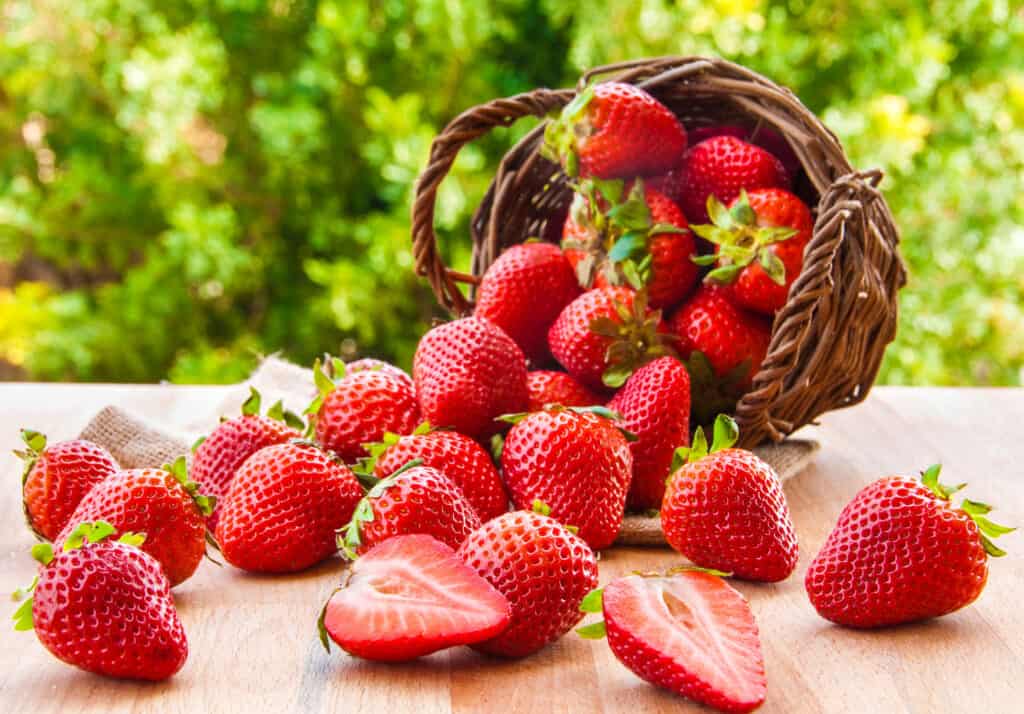
Introduction
- Botanical Name: Fragaria × ananassa
- Family: Rosaceae
- Chromosome Number: 2n = 56
- Origin: Temperate regions of Europe & America
- Common Name: Strawberry
- Economic Importance: High-value fruit crop used in fresh consumption, processed foods (jams, jellies, juices, ice creams, etc.)
Climatic & Soil Requirements
Climate
- Ideal Temperature: 15–25°C (Grows best in temperate & subtropical regions)
- Chilling Requirement: Needs 300–400 hours of chilling below 7°C for proper flowering & fruiting.
- Day Length: Short-day plant; prefers 8–12 hours of daylight.
- Altitude: Grows well in 800–2500 m above sea level.
Soil Requirements
- Soil Type: Prefers well-drained sandy loam to loamy soil with high organic matter.
- pH Range: 5.5–6.5 (Slightly acidic).
- Drainage: Good drainage is necessary; waterlogging is harmful.
Varieties of Strawberry
International Varieties
- Chandler – High yield, sweet fruits.
- Sweet Charlie – Early maturing, disease resistant.
- Camarosa – Large fruit size, high shelf life.
- Festival – High-yielding variety, good for processing.
Indian Varieties
- Pusa Early Dwarf – Developed by IARI, early maturing.
- Pusa Strawberry – Sweet fruits, good for fresh consumption.
- Winter Dawn – High productivity, grown in Mahabaleshwar (Maharashtra).
- Sweet Sensation – Resistant to fungal diseases.
Propagation & Planting
Propagation Methods
- By Runners: Most common method; runners (stolons) develop into new plants.
- By Tissue Culture: Used for large-scale, disease-free plant production.
- By Crown Division: Splitting the crown into sections for propagation.
Planting Time
- Temperate Regions: July–September
- Subtropical Regions: October–November
Planting Method
- Spacing: 30 cm × 30 cm (Ridges & furrows method).
- Planting Depth: Crown should be at soil level (not too deep or shallow).
- Mulching: Essential to prevent weed growth & conserve moisture (Plastic mulch preferred).
Irrigation & Nutrient Management
Irrigation
- Critical Stages: Flowering & fruit development.
- Method: Drip irrigation is best (reduces fungal diseases).
- Frequency: Once every 3–4 days (avoid overwatering).
Nutrient Requirement (per hectare)
- FYM: 20–30 tons
- Nitrogen (N): 80–100 kg
- Phosphorus (P₂O₅): 40–50 kg
- Potassium (K₂O): 80–100 kg
- Micronutrients: Boron & Zinc improve fruit quality.
- Application Method: Split doses (Before planting, flowering, & fruiting).
Pollination & Flowering
- Self-pollinated, but bees improve yield.
- Flowering: Starts 45–60 days after planting.
- Hand Pollination: Sometimes used in greenhouses.
Pest & Disease Management
Major Pests
|
Pest |
Symptoms |
Control Measures |
|
Aphids |
Curling of leaves, honeydew secretion |
Spray Neem oil or Imidacloprid |
|
Mites |
Yellowing of leaves, webbing on plants |
Use Acaricides (Abamectin) |
|
Cutworms |
Damage to roots & crown |
Apply Chlorpyrifos in soil |
|
Thrips |
Scarring on fruits, reduced fruit size |
Spray Spinosad or Fipronil |
Major Diseases
|
Disease |
Symptoms |
Control Measures |
|
Powdery Mildew |
White powdery spots on leaves |
Use Sulfur-based fungicides |
|
Grey Mold (Botrytis) |
Fungal growth on fruits |
Apply Captan or Carbendazim |
|
Leaf Spot |
Brownish spots on leaves |
Spray Copper Oxychloride |
|
Anthracnose |
Dark sunken spots on fruits |
Use Chlorothalonil or Mancozeb |
Harvesting & Yield
Harvesting
- Time: After 80–100 days from planting.
- Maturity Index: Fruits turn red & soft (Harvest when 75–90% red).
- Harvesting Method: Handpicking (done in the morning).
- Storage: Stored at 0–4°C for 7–10 days.
Yield
- Open Field: 20–25 tons/ha
- Greenhouse: 30–40 tons/ha
Post-Harvest Management
- Sorting & Grading: Based on fruit size & color.
- Packaging: Packed in ventilated plastic trays.
- Processing: Used for making jams, jellies, ice creams, juice, etc.
- Transport: Refrigerated transport preferred to avoid spoilage.

